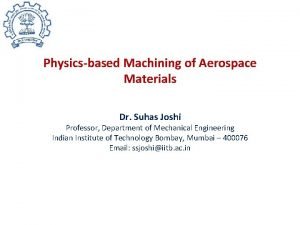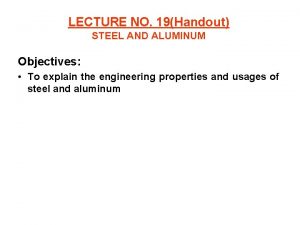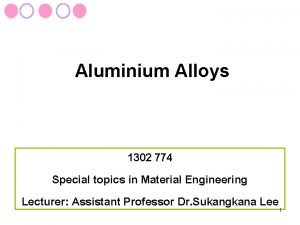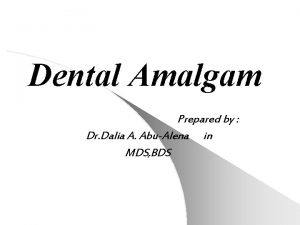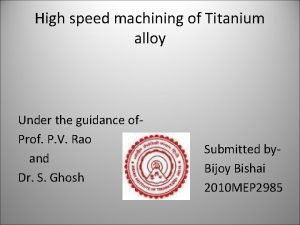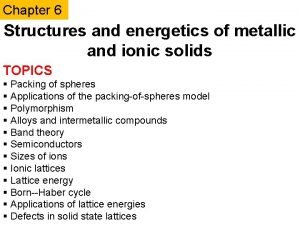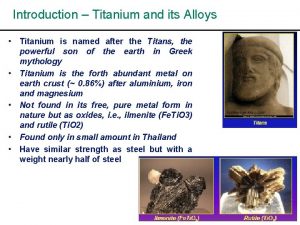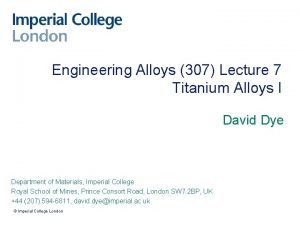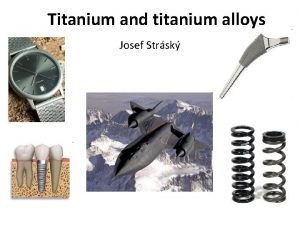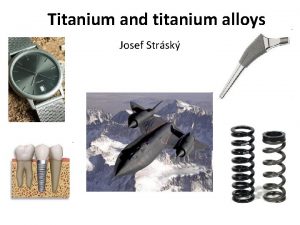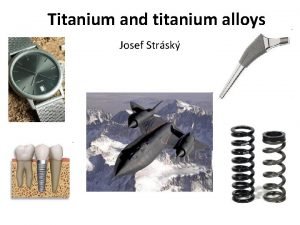Titanium its Alloys Introduction v Titanium v High






- Slides: 6

Titanium & its Alloys Introduction: v Titanium: v High melting point o. Tm = 3035 of (1575 o. C ). v r (4. 51 g/cm 3), therefore it has higher (Strength/weight), so they are particularly useful for aircraft parts. v Has excellent Corrosion resistance upto (1000 of). v There was a possibility of developing (Ti) alloy with strength at elevated o. T which might substitute in military equipment for (Ni – base alloys) or (Co – base alloys). v has a strong affinity for the gases (H 2, N 2, O 2) all of which form Interstitial solid solution with Ti marked strengthing effect at specified limit when the amount of (absorbed O 2, N 2, H 2) – exceeding this limit will cause: Embrittle Ti Reducing impact s. Cause brittle failure under sustained load at low stress. v Ti has (C. P. H. ) crystal structure called (a ) at o. RT 882 o. C (b. c. c (b).

Titanium & its Alloys Titanium alloys: v The addition of alloying element to (Ti) will influence the Transformation o. T. alloying elements a stabilizer (Al) [Transformation o. T b stabilizer ) ] (Cr, Mo, V, Mn, Fe) [Transformation o. T v. Single phase alloys (a-b ] Weldable. Good ductility. - Some two phase are also weldable but their welds less ductile. - Two phase are stronger than the one – phase c) ( b ) is a stronger than (c. p. h) ( a ) alloys because (b. c. - Two phase alloys can be strengthened by heat treated because the microstructure can be manipulated by controlling heating, Quenching.

Titanium & its Alloys Titanium alloys: a alloys (a + b) alloys b alloys a alloys: v Most of ( a ) alloys contain some ( b ) stabilizing alloying elements, the composition of these alloys are balanced by higher (Al%). v (Ti + 5% Al +2. 5% Sn) is one of ( a ) alloys, a typical uses of this alloys: Aircraft tail pipe. Formed sheet component operate upto (900 of). Missile fuel tank. Structure parts operating for short time upto (1100 of).

Titanium & its Alloys v ( a ) alloys have two main attributes: Weldability (result from the one phase microstructure) Re-tension of ( s ) at high o. T (result from the Al) (a + b) alloys v They contain enough ( b ) stabilizing elements to cause ( b ) phases to persist down at o. RT. v They are stronger than ( a ) alloys. v Typical application of (Ti - 6% Al – 4% V) alloys include: Aircraft gas turbine. Compressors blades & disks. Forged aircraft fitting. Sheet metal air frame parts. ( Ti – 8% Mn ) has been used for: Aircraft skins. Structure parts subjected to (200 – 600 of)

Titanium & its Alloys ( b ) alloys v ( b ) alloys can be strengthened by heat treatment, unlike ( a ) alloys [(3% Al – 13% V – 11% Cr) b alloys]. v ( b ) alloys have been used for: High strength fasteners. Aerospace components requiring high ( s ) at moderate o. T. Heat Treatment for Titanium: Annealing temperature is (1100 – 1350 of) Stress relieve at (1000 of) for (15 – 20 min) followed by Air Cooled.

Titanium & its Alloys a alloys: (a + b) alloys (Ti – 5% Al – 2. 5% Sn) (Ti – 8% Mn) v Can’t be strengthened by heat treated. v Annealing (Full – annealing), heating at (1500 of) for (30 min). v Stress relieve can be accomplished by heating at (1000 – 1200 of) for (1 – 2 ) hr. v Full annealing (heating to 1250 – 1300 of) for (1) hr, cool to (900 of) at (5 of/ min) then Air Cooled. (Ti – 6% Al – 4% V) v Quenching v Solution H. T. at (1550 – 1750 of), hold for (15 – 30 min). v Water Quenched. v Aged at (900 – 1000 of) for (4 – 8 hr) + Air cooled. ( b ) alloys (Ti– 3% Al– 13% V-11% Cr) v Solution treated (1450 of) for (10 min). v Quenching. v Aging at elevated o. T precipitation of fine particles of ( a + Ti Cr 2), ( s ) = 21500 psi %E = 5%. suppress the transformation of the ( b ) phase. v Aging at elevated o. T precipitation of fine particles of ( a ) phase in volume of heat were ( b ) grains prior to quenching. This fine structure is stronger than coarse annealed ( a + b ) structure.
